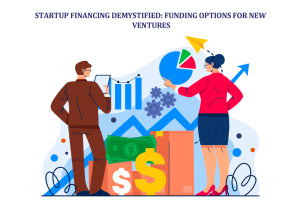Most Popular Revenue Models For Startups

How will your startup make money?
There’s more than one way for your startup business to make money. More and more companies appear to be taking the luxury of self-funding or raising large early rounds so that they can focus on tasting success and then, finding revenue later.
Others have focused on building a profitable business out of the gate, even if that means bootstrapping. These businesses can enjoy a lot of flexibility and options. As they go along, they may generate the most interest in companies looking at inbound acquisition. Whichever path you choose, you should have an idea of how you will generate revenues, income, and cash flow
Here are just some of your options…
Ad Based Revenues
Many customers out there appear to prefer to watch ads than to pay for services. This is a great way for businesses to make money without technically charging users for anything.
This was YouTube’s main model until recently, and many other websites were also working on the same strategy. As a platform operator, you can sell ad space, secure sponsors, and even, take commissions on affiliate programs. Of course, taken too far, this can be counterproductive. And, that was the end of television. There came a time when there were more commercials being shown than actual content. As a result, people tuned out.
You may have had the same frustration with the radio, and may now have SiriusXM in your car or plug in your phone instead. Many websites are making the same mistakes. As if one ad or popup isn’t enough, they’ve replaced your whole screen with endless ads and popups. You can’t even see the content anymore.
That probably isn’t a model that will last. People are turning to social media platforms like Instagram because there are more ads on regular media than authentic content.
Subscription Models
Subscription and service models have become much more popular in the past few years. We’ve seen this with the rise of SaaS. This model spread to the food sector, healthcare, automobiles, and even real estate. Although, some customers may now find they have way too many different subscriptions, many savvy entrepreneurs find that this revenue model continues to have many advantages. While businesses do earn recurring income, the model forces them to continue to wow customers every month, to keep innovating, and truly provide a great service.
Marketplace Startups
Marketplace startups can incorporate many of the above revenue sources to bring in money. Yet, they are different since they are two-dimensional, and include suppliers and consumers. Marketplaces can be very challenging, even for the most talented founders. When building a business from scratch, you are essentially bringing in customers on two fronts at the same time. It is a juggling act. Customers won’t have a good experience or stay if the suppliers aren’t there. Suppliers won’t hang around long or make much effort if the buyers aren’t there.
Product Sales
The most traditional model for generating revenues is, of course, selling a product. We will always need products in one form or another. Product sales provide an in and out and paid relationship. That can have perks and cons because it’s easy to lose the customer. There can be less pressure to really deliver your best and provide great ongoing service. Many VCs and other investors have also been scared off by hardware and physical products. That’s because they involve more development and inventory, and tied-up capital.
Freemium
Once a laughed-at model that no one thought could turn into a sustainable revenue generator, freemium has become very popular. Though, it may still seem unclear how some companies plan to make money.
They have given away their services, but don’t have a strong revenue model. Done right, freemium is a two-part model. You have the free part which brings everyone in. Then, you have the premium part. That’s where the money comes in. Like, you can join LinkedIn and build some connections slowly as an amateur user.
Or, you can go premium and use it to advertise, recruit, and get a lot more data and value. There are hundreds of mobile apps like this too. If you have kids, watch out for those with ‘in-app purchases’. Before you know it all types of charges are showing up on your accounts for virtual gear that your kids are buying. Some of those virtual items can go up to millions of dollars.
Secondary Revenue Based Models
Facebook is probably one of the most notable to pioneer one of these revenue models. Facebook makes money in a lot of ways. One of the most significant that has been so controversially made clear recently is selling all of your data. They so kindly and generously let you use their social platform, they let you buy and watch ads, and then, they really bank by selling everything about you. There are countless apps that do this too, or give you a free app download in exchange for access all the data they can through your phone. The big credit bureaus do this by selling your information to as many buyers as they can every day.
B2B Or B2C
One of the biggest decisions you’ll make is whether you start out focusing on selling to and generating revenues from B2B (business to business) or B2C (business to customer) users.
Enterprise Sales
More and savvier startup founders are focusing on enterprise-level sales. That is, selling through the biggest organizations out there. It can present extra challenges. It may take a year or two to nurture each client through the sales cycle.
You are also relying on a very small number of available customers. This can have two major advantages. Each sale can be worth a lot. Easily tens of thousands to millions of dollars. Second, if you are a very technical founder, you can use enterprise clients and their massive and very skilled sales teams to tap into millions of users overnight. Think about the difference in Google selling your product for you to all their users tomorrow.
Summary
There are many ways for your startup to generate revenue. If you have revenue and profits you have more options. You have more negotiating power when it comes to raising money and selling your business. For more information on how this affects you throughout your startup journey, check out this fundraising training and M&A advisory service.
BIO
Alejandro Cremades is a serial entrepreneur and the author of The Art of Startup Fundraising. With a foreword by ‘Shark Tank‘ star Barbara Corcoran, and published by John Wiley & Sons, the book was named one of the best books for entrepreneurs. The book offers a step-by-step guide to today‘s way of raising money for entrepreneurs.
Most recently, Alejandro built and exited CoFoundersLab which is one of the largest communities of founders online.
Prior to CoFoundersLab, Alejandro worked as a lawyer at King & Spalding where he was involved in one of the biggest investment arbitration cases in history ($113 billion at stake).
Alejandro is an active speaker and has given guest lectures at the Wharton School of Business, Columbia Business School, and at NYU Stern School of Business.
Alejandro has been involved with the JOBS Act since inception and was invited to the White House and the US House of Representatives to provide his stands on the new regulatory changes concerning fundraising online.






